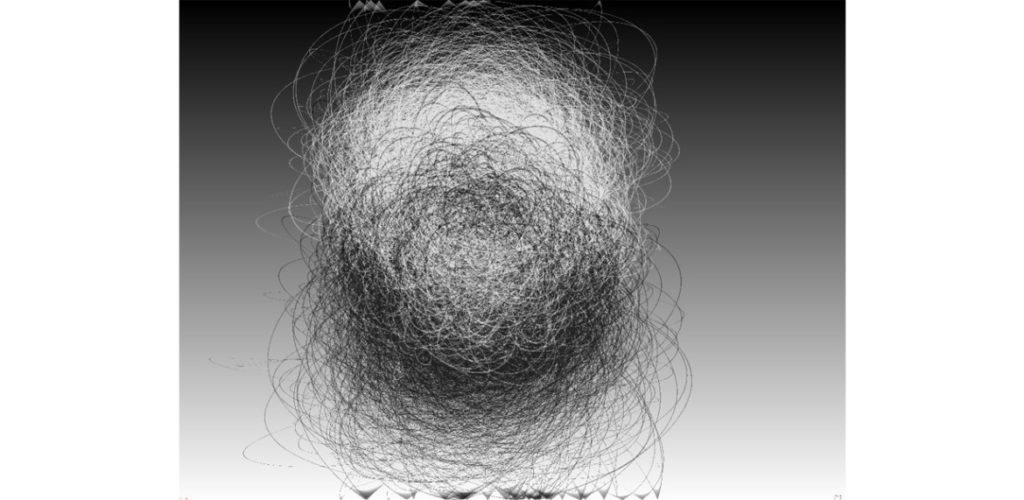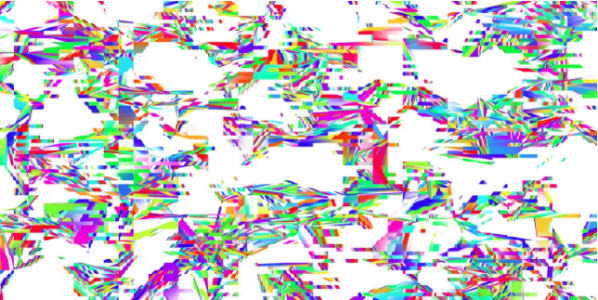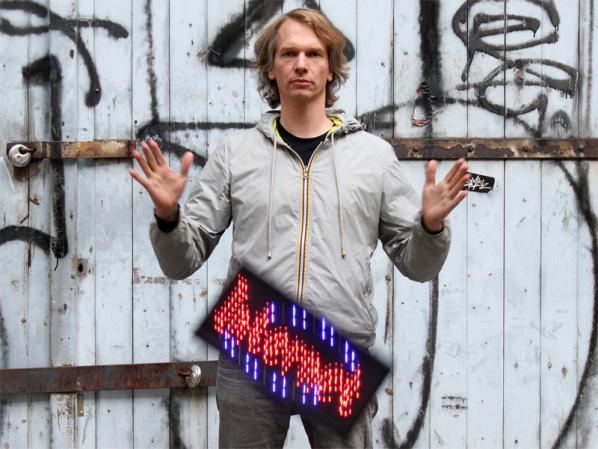



Copyright has been a relevant topic since the development of the printing press. It grants the author the exclusive right to reproduce, publish, and sell the content and form of intellectual property. The copy & paste mentality of the Internet user brought chaos to the system. Blockchain technology should now manage the author and marketing rights in a way that is more transparent, completely free of Bitcoin and monetary background. The idea had its origin in the art scene.
The Internet is a space without horizons or frontiers. It has changed our environment and also, thereby, our sensory perception. In ‘the real world’ we are confronted everywhere by people gazing deeply into smartphones: on the street, on the subway, in airplanes, in queues and cafés. Interpersonal dialogue is increasingly being conducted in the virtual sphere. How does the art scene react to new technological developments in arts? I asked Alain Servais (collector), Wolf Lieser (gallerist) and Aram Bartholl (artist.)
AD: Alain, you are collector of digital art since many years. How actively do you use the Internet and the possibilities that it brings for research into art?
AS: I have the opportunity to generally be able to experience art in the real. This is still an indispensable element in the process of acquiring. I’m a big user of the Internet when it’s a question of looking for information on art that’s of interest to me. The key information I always try to gather before acquiring a work is: – a document collating the works which have marked the evolution of the artist’s practice –a piece of writing by an academic, curator or critic contextualizing the artist’s work – an interview with the artist, as I want to hear his/her ‘ voice’ speaking about on his/her art – and a biography.
AD: Wolf, how much do you use the Internet and its possibilities for better marketing in the art scene?WL: We have a presence on various social media and websites, for example, FB, FLICKR, Bpigs, ArtfactsNet, etc. But we try to limit it to those pages that are relevant to art. As an actual communication medium we primarily use Facebook.
AD: Aram, killyourphone.com provides relief and a critique of technology. What would your subjects be without the Internet?
AB: Despite rising levels of communication across devices and networks, I nonetheless notice how, when friends express their opinions on the social media channels, they do so ever more consciously and selectively. We’ve come to understand that all of the commentary and spontaneous utterances on Twitter, FB & co no longer just disappear, but are saved, analyzed and used. ‘Private is the new public’, said Geraldine Juarez recently. The belief that the net makes the world fantastically democratic and offers an equal chance for everyone has, at least since Snowden’s revelations, been finally buried. To that extent, the theme ‘how would it be without the Internet?’ is very interesting! How could we communicate without central, monitoring services? Which low-tech DIY technologies are available in order to exchange data ‘offline’? How can we live without Google?… (A self-test is strongly recommended).
The interplay between the old and new environments leads to numerous uncertainties and generational conflicts. While some nostalgic digital immigrants still assess the advantages of the digital world as being synthetic, alien and unsocial, to the generation of digital natives, the digital abundance is felt as entirely natural. For them, the new technologies were with them in the cradle.

AD: Alain, you are a digital immigrant. What was the first media work in your collection? When did you buy it and why?
AL: My first experience with digital art was with bitforms gallery in NY, more than 10 years ago – at a time when it was really under the radar. I went to an exhibition by Mark Napier from whom I acquired a work at that time – one of the “Old Testament” pieces. That was very natural for me, because I was looking for some new kind of art. I knew enough of art history to know that every important movement in art was always linked to a social, economical, technological, psychological development in society. It was a time, when I was trying to collect works that were really addicted/connected to the actual world, the world around us. I was thinking, ok let’s put myself in 2150: when I’ll be using my third heart and my second brain, what will I say was important in the year 1999/ 2000? Without any doubt it will be the computer and the Internet 2.0 with Facebook and social networks and everything. Eventually I thought: wow people were creating art and it is digital. I immediately considered it to be a very important development for the arts.
AD: Wolf, you procure and sell digital art. What do you think today is the greatest obstacle to understanding the effect of new media?
WL: The sale and procurement via the Internet leads to superficiality. This is, at least, my perception. Experiencing art on a website, interactively or not, is often characterized by shorter cycles/loops compared to viewing the same website here in the gallery. I think we need, as we always did, a balance between the real and the virtual. And actually, this makes sense, because we ourselves do embody both. It’s a reason why the digital natives often express themselves in analog media – it’s no coincidence!

AD: Aram, your works stand at the charged interface between public and private, online and offline, between technological infatuation and everyday life, whereby you teach us how to better understand our new environment. ‘ Whoever sharpens our perception tends to [be] antisocial …’, said media theorist Marshall McLuhan. Is it true?
AB: Especially TODAY it is more important than ever to sharpen perception with regard to the effects of technological development. Two and a half years after Snowden the public discussion on privacy and mass surveillance continues to level off. While the big secret services use their hefty budgets to snow us under, and to lock the doors to the NSA, the interest in further explosive leaks from the Snowden documents is fading. ‘Nothing to hide’ is the mantra of the ‘Smart New World’, in which we can neither see nor sense the complex mechanisms of surveillance. In contrast to the dystopic Matrix scenario, our world will ever be fluffier, smarter and more comfortable, unless one has the wrong passport or sits on a bus next to a presumed terrorist. Then reality will be brutal. Precisely for these reasons it is so important to make the hidden, abstract data world understandable, whether through concrete images, objects, or installations. If you were to hold 8 volumes with 4.7 million passwords of LinkedIn users in your hand hand, you would suddenly understand the significance of the security of our online identities.
Copyright has been a relevant topic since the development of the printing press. It grants the author the exclusive right to reproduce, publish, and sell the content and form of intellectual property. The copy & paste mentality of the Internet user brought chaos to the system. The blockchain technology should now manage the author and marketing rights in a way that is more transparent, completely free of Bitcoin and monetary background. The idea had its origin in the art scene.
AD: Alain, do you think the further development of the blockchain lead to more transparency and protection against forgery?
AS: I would not use the word forgery, but certainly [against] an unfair use of material or a copyright infringement. I suppose that the blockchain is one path that should be investigated and tested for the copyright protection of online works of art. I believe in a transformation of the economy of the market for online art towards the direction of a wider distribution through, perhaps, a ‘renting’ of the work rather than an illusory acquisition (taking into account the copyright stays with the artist anyway). i-tunes and Spotify both adapted well to the online art economy.
AD: Wolf, do you make use of these new possibilities within the marketing of digital art? And have you already thought about a new currency model?
WL: I’ve already been confronted by this and I think that it makes sense. With my artists though there’s as yet no need or willingness. I’ve yet to engage with new currency models.
AD: Aram, to what extent is the blockchain and Bitcoin really discussed within artist circles?
AB: Services like Wikipedia, the Open-Source Software movement and, in principle, the entire World Wide Web wouldn’t exist at all today had Telco-payment-services pushed through its fee-based BTX/videotext with pay-per-view, in the 1980s. Naturally the possibility turns the never-ending reproduction of classic markets on its head, and in recent years, there have been extensive debates about copyright and intellectual property. We shouldn’t forget though, that a large part of the software that operates the Internet and millions of devices came about in the spirit of the sharing-culture. The blockchain is a powerful tool, which introduces a form of artificial scarcity into the digital environment. It’s up to each artist himself or herself whether and how he or she chooses to distribute their work. The art market and the demand will certainly create some model or other for the sale and distribution of art that only exists in bits and bytes. Let’s wait and see…
